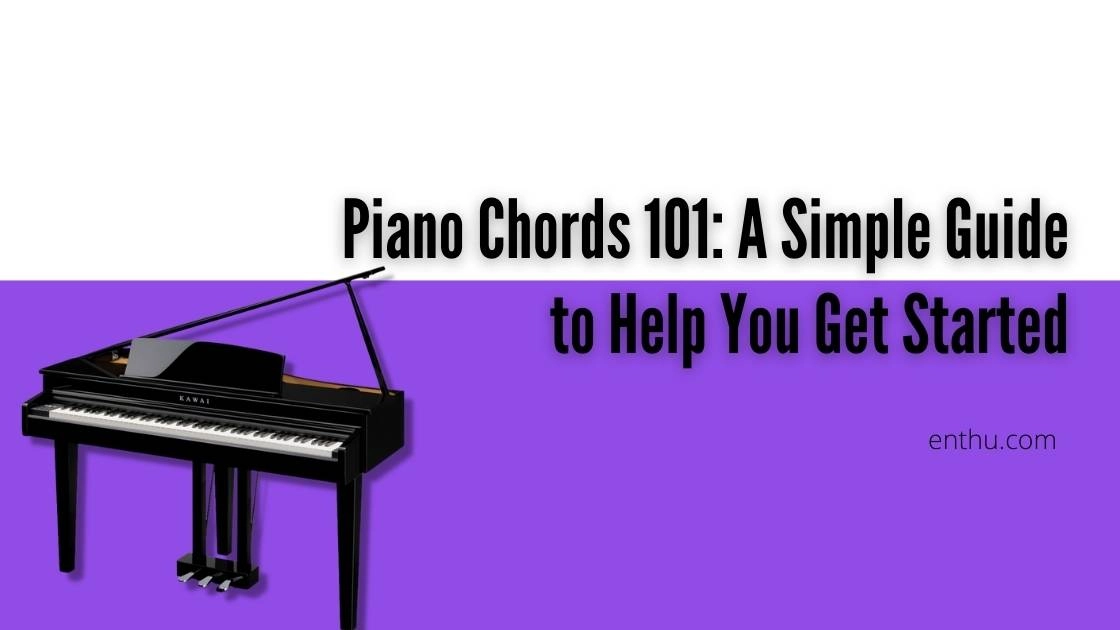How about enjoying tasty fries while watching your favorite movie? I know it's tempting. But a little extra or less salt can make a difference and change the taste.
Yes, a little something can bring a significant change. Want to see how this theory can be applied musically? Then stick around. Do you know how the most beautiful piano pieces were composed and won many hearts?
The credit goes to the arrangement of chords. We all enjoy melodies but do you know how to tell if a chord is major or minor? Yes.
The differentiation can be made per the theory we saw in the above example.
How to Tell If a Chord is Major or Minor?

You must have experimented with the psychological theory that major chords sound happy and minor chords sound sad. Well, I wouldn't say it's wrong.
But is it the only way to differentiate chords? Nope! The music theory is much deeper than this.
So, let's dig into chord theory a bit before determining the differences between major and minor chords.
1. What is a Major Chord?
It is a combination of the major triad that contains the 1st, 3rd, and 5th notes of a major scale. Let's take the C major scale for instance.
The formula of the C major scale is C D E F G A B C. So, how do we form a C major chord? We need 1st(root) note C, 3rd note E, and 5th note G. So, the C major formula will be C - E - G. Let's move ahead with minor chord theory.
2. What is a Minor Chord?
Here the less salt in fries we discussed comes into the picture. Like the major chord, the minor one has a structure of 1st note, 3rd note, and 5th note. The minor one includes the 3rd note, just by lowering or flattening down by half step.
Considering the C minor scale, the C minor formula will be C - Eb - G. A slight change in one note brings a big change and differentiates the major and minor chords.
That one note possesses the power of delegating unique characteristics to the chords. You can use this formula while identifying if a chord is minor or major. Besides that, 4 pillars can help you to identify if a chord is minor or major. Which basic chords a beginner should start with?

Pillars to Identify Major and Minor Chords
1. Tonal Quality of Chords
To understand this pillar, you need to know the tonic or tonal center. When you hear a tune landing homely on a specific pitch, that pitch is called Tonic or Tonal center. In the C major scale, the root note C is the tonic.
This theory is familiar with the musical modes in Western music where you consider any note as a tonal center and form a new scale. In the context of identifying the nature of chords, the tonal quality is nothing but how a chord sounds.

It can be happy, sad, restless, heavy, calming, or soothing. So, you can recognize major or minor chord basis how it sounds.
2. Ear and Vision to Identify Major or Minor
For this, you need to concentrate on how a chord sounds. You can grasp this skill with practice by spending at least 20 minutes daily training your ears. Visualize the chord while listening to the sound. Concentrate on the notes. Listen to some melodies and try to figure out how notes are used in that musical piece.
3. Sheet Music to Identify Major or Minor Nature
You can find out the qualities of chords while reading sheet music. How? Of course, with the key signature. Now, don't get confused between the key signature and the time signature The key signature tells about sharps and flats.

Whereas, time signature indicates beats in every measure of a piece of music. It's effortless to find sharps and flats and, ultimately, the major or minor nature. The key signature is presented at the beginning of every staff as you can see in the picture.
Key signatures are there because the major and minor chords follow a pattern of intervals. Intervals play a vital role in the key signature.
4. The Interval Structure
This approach to identifying chords might seem difficult. But once you know the rules and formula, you can determine which chord is in the key of a minor or major. Interval is the distance between two consecutive notes, such as C to C# (half step) or D to E (whole step).
The formation of a semitone - tone or half-step - whole step tweaks the tonality of notes and, eventually, the chords. As we know, lowering down the 3rd note changes the nature of the chord:
The Third note in a major chord is 4 semitones away
The Third note in a minor chord is 3 semitones away
The fifth note in a major chord is 3 semitones away
The fifth note in a minor chord is 4 semitones away
Continuing the same example of C major and C minor chord: C major chord - C to E = 4 semitones and E to G = 3 semitones C minor chord - C to Eb = 3 semitones and Eb to G = 4 semitones In light of the above discussion, you must have understood how intervals help identify the chords, along with key signatures.
Identifying major and minor chords is not difficult if you know how they are distinct from each other. Keeping that in mind, let's summarize the difference between major and minor chords with a handful and accessible points.
Difference between Major Chords and Minor Chords
Major Chords | Minor Chords |
A major chord includes a natural or major 3rd. | A minor chord includes a minor or flat 3rd. |
Major chords sound happy, pleasant, or soothing. | Minor chords sound sad or a little restless. |
A major third is at a distance of 4 semitones. | A minor third is at a distance of 3 semitones. |
Example - C major chord is C E G. | Example - C minor chord is C Eb G. |
Example of a Song in Major - Imagine by John Lennon is based on the C major chord. | Example of a Song in Minor - Toxic by Britney Spears has a base of C minor. These grounds are enough for a beginner to recognize if a chord is major or minor. In addition to that, I highly recommend practicing. |
These grounds are enough for a beginner to recognize if a chord is major or minor. In addition to that, I highly recommend practicing piano scales regularly to get better at chords. Well, what can be better than garnishing your skill with some best piano exercises?




Conclusion
Chords are like colors. They have their individuality as well as shades. Identifying major and minor chords is not tricky, but not as easy as it sounds. It takes consistent practice to get better at the piano. Practicing scales and chords is as essential as learning them.
Learn more about different chords like diminished chords or diatonic chords to grasp more knowledge about chord theory. You can learn under the guidance of a teacher to master chord theory.
You can also learn piano online for free on the best platforms. I hope you find this guide helpful. Stay tuned till we meet in the next read.
FAQs
1) How can I identify if a song is in minor or major?
You can quickly identify if a song is in minor or major by the following factors:
Tonal center
Melody
Expressions
Ear
Sheet music
2) Can I play piano by ear?
Yes, you can play piano by ear. For that, you must carefully listen to a melody. Try to recognize chord progression and then play the same on the piano. If you match it with the keys on the piano, you are about to master the skill of playing piano by ear.
3) Why do minor chords or songs in minor sound sad?
Minor chords and songs in the minor key sound sad because they induce sorrowful emotions. The characteristics of minor chords are based on darker emotions that touch the listener's heart. Another reason is people are used to this assumption that minors always sound sad. However, minor keys are a blend of mixed vibes.


Comments